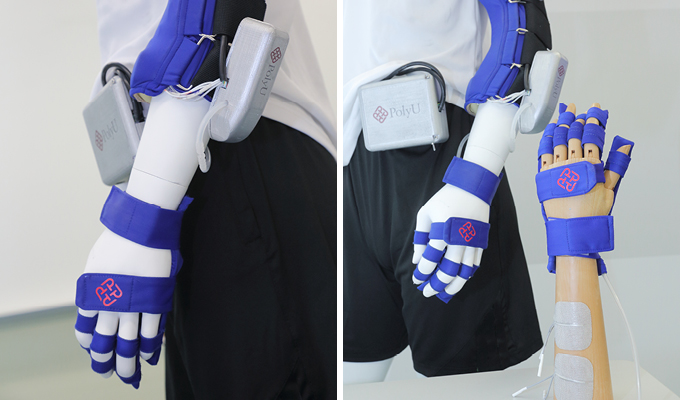Regular and intensive rehabilitation training are critical for patients’ post-stroke recovery. Dr Hu Xiao-ling of the Department of Biomedical Engineering introduced the “mobile exo-neuro-musculo-skeleton”, a robotic arm that can enable stroke patients to conduct rehabilitation exercise anytime and anywhere after discharge from hospital to enhance the rehabilitation progress.
1. What prompted you to develop the “mobile exo-neuro-musculo-skeleton”?
Stroke is the third leading cause of disability worldwide. In Hong Kong, there are about 25,000 new incidences of stroke annually in recent years. While intensive, repeated and long-term rehabilitation training are critical for enhancing the physical mobility of stroke patients and for alleviating their post-stroke symptoms, access to outpatient rehabilitation treatment has been difficult due to overwhelming demand. Stroke patients also find it challenging to travel from home to outpatient clinics.
In view of this, I wanted to develop a flexible and easy-to-use rehabilitation training device that could enable patients to engage in intensive and effective self-help rehabilitation exercise anytime and anywhere to enhance recovery after discharged from hospital.
2. How does the “mobile exo-neuro-musculo-skeleton” work?
The “mobile exo-neuro-musculo-skeleton” is a robotic arm that integrates exo-skeleton and soft robot structural designs with the PolyU-patented Neuro-muscular Electrical Stimulation (NMES) technology. Upon detecting the electromyography signals at the patient’s muscles, the device will respond by applying NMES to contract the muscles, as well as exerting external mechanical forces to assist the patient’s joint movement for the desired rehabilitation outcomes.
3. What are the advantages of the “mobile exo-neuro-musculo-skeleton” over existing exo-skeleton and soft robot structural technology?
Conventional exo-skeleton structure is mainly constructed by orthotic materials such as metal and plastic, making it heavy and uncomfortable to wear. Existing soft robot provides external forces by air-filled or liquid-filled components to assist upper-limb joint movements. Such structure is light in weight but very bulky in size. Both types of structures demand high electrical power for driving motors or pumps, thus it is not convenient for patients to use them outside hospitals or rehabilitation centres.
On the contrary, our mobile exo-neuro-musculo-skeleton is light in weight, compact in size, fast in response to signals and demands minimal power supply, and is therefore suitable for use in both indoor and outdoor environments. Consisting of components for wrist/hand, elbow, and fingers, the robotic arm can be worn separately or together for different functional training needs. Using washable fabric with ultraviolet protection and good ventilation, the robotic arm is comfortable for the patients.
4. What were the outcomes of using the robotic arm?
10 stroke patients took part in an initial trial of the robotic arm. After completing 20 two-hour training sessions, they displayed better muscle coordination, wrist and finger functions, and lower muscle spasticity. Going forward, further clinical trials will be carried out in collaboration with hospitals and clinics.
